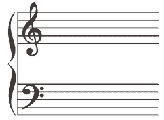How to Write Music

If you’re really going to learn an instrument you’ll need to learn how to read music. But there are some who learn alone who don’t bother, simply playing by ear. However, what if you decide to write a piece of music that you want others to play. Teaching each person their part by ear simply isn’t practical. What you need to do is learn to write music.
The Basics
Music is written on a stave of five parallel lines, like this:
 |
These contain the notation, and from the position of the stave you can see what the note is. However, each stave is a clef, and there are two, treble and bass, shown here with bass on the bottom:
 |
There can be a line between the two staves, which is the home of “middle” C. So, using space and lines from that up to the top of the treble clef, you’d have C,D,E,F,G,A,B,C,D,E, F.
Time Signature
Whatever the piece of music, it will be in a certain time signature, which is written after the treble or bass clef. If it’s four beats to the bar, it’s 4/4, or common time. 3/4 is waltz time, with three beats to the bar. But it can also be in 6/8, or almost anytime, depending on the piece. Certainly, if you’re beginning, it’ll probably be in 4/4, with four quarter beats, or crotchets to the bar. Count it out, with the emphasis on the first beat of each bar. If it’s 1-2-3-4-1-2-3-4, then it’s 4/4, so write that for people who will play it. The end of each bar is noted by a vertical line through the staff.
Note Values
A whole note, or semi-breve, will take up an entire bar of 4/4, and last four beats. It looks like this:
 |
A minim is half the value of a semi-breve, lasting two beats, and written like this:
 |
The crotchet is one beat in a 4/4 bar:
 |
A quaver lasts half as long as a crotchet:
 |
A semi-quaver is half as long as a quaver:
 |
Finally there’s the demisemiquaver, whose value is half a semiquaver:
 |
Writing Music
If you haven’t written music before, working out the relative values of the notes can be confusing. The best solution is to write a draft and have someone play it who reads music well. You’ll probably have made mistakes, but that’s fine; it’s a good way to learn. You’ll be able to go back and correct more knowledgeably.
Keys
In addition to having a time signature, every piece of music is in a certain key, too. If you use only whole notes (ABCDEFG), then it’s in C, and you don’t need to make a notation. If, however, the F is sharp each time, then you’re in G, and you’d write # (the notation for sharp) after the time signature on the clef, in the space between E and G. If your piece always has a B flat, then it’s in F, and you’d write b on the middle line of the treble clef. There are a large number of keys, and you should learn them all, or at least have a reference chart before you sit down to write.
This isn’t a complete guide, by any means. However, it does offer you a start in learning how to write music. From here, with a little help, you’ll be able to put your piece – and all that follow – on paper.
- Finding Sheet Music & Music Books
- Learning Other Musical Styles
- Playing Other Styles Of Music
- Playing With Others
- Recording at Home
- Equipment for Making Music
- Finding a Gig
- Music Notation Software
- Working With The Engineer
- How to Play Guitar
- Rehearsing With Your Band
- Forming a Band
- Influential Music
- Song Arranging
- Songwriting


Re: Do You Need Qualifications to Be a Music Therapist?
O am interested n volunteer work i have one passion which is music i write sell and perform also…
Re: The History of Reggae
sorry that was my son messing around but I love reggae and have studied the effect of music on the brain and it is quite amazing if I do…
Re: Singing in a Choir
You know there is a singing trainer nearby Carshalton
Re: Group Lessons: Suzuki Method
Hello, this isn't true. Children start with individual lessons as well as having group lessons. Group lessons are used to…
Re: Changing Teachers
@oliver. There is a problem with Jane's email unfortunately. Can you please send an email to cb@pts.com and I'll sort it out for you.
Re: Changing Teachers
Hello, This is a question to the site admin. I have tried to contact you several times and can't get a response from anyone. I have sent a…
Re: Do You Need Qualifications to Be a Music Therapist?
hmmm.music is really what makes me happy .i can 't stop thinking of it thank you .
Re: Mixing Down the Music Tracks
Good clear account and very useful. Would be useful to expand to include a few more technical points on particular FX's and…
Re: The History of Pop Music
Thanks for sharing this historical tutorials regarding the pop Music. After reading this tutorials. there are may question are coming…
Re: The History of Blues
Hi, I was wondering if i can apply as a violin teacher? Thanks!